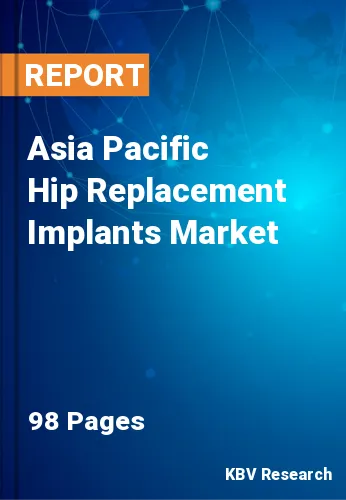The Asia Pacific Hip Replacement Implants Market would witness market growth of 6.4% CAGR during the forecast period (2019-2025). Facts of overweight and obese are projected by the World Health Organization for at least one in the three adult populations worldwide. There are also over 40 million obese children under the age of 5. Overweight or obese can have a severe health effect. Carrying additional fat has severe health implications including osteoarthritis, musculoskeletal illnesses. These conditions are responsible for premature death and significant disability. In and around the globe, osteoarthritis (OA) is very common. It is a major source of disability and can affect the physical and psychological wellbeing of individuals.
Health resources and costs related to disease management can be significant. Different OA phenotypes are being increasingly demonstrated to reflect various illness mechanisms. Several threat factors of human limits are identified, including sociodemographic (e.g. women's gender, African-American race), genetic predisposition, obesity, dietary factors, and bone density/mass. Specific bone/joint shapes, muscle weakness of the thigh flexor, joint misalignment, engagement in particular occupational / sports operations and joint injury include joint risk factors.
In the forecast period, Asia-Pacific is anticipated to see significant progress. The boom will continue in several years, with the proliferation of factors like the increase in health expenditures in Asian emerging markets and the increasingly older population that pose a bigger risk of osteoarthritis, osteoporosis and bone injuries. Furthermore, owing to the growing medical tourism sector, the rapid development of healthcare infrastructure stimulates market supply in the region.
In nations like China and India, the availability of resources that allow advanced technologies to be produced at lower prices results in manufacturing growth. Furthermore, China released Order 650-the Medical Device Supervision and Administration Regulations, which intended to limit foreign investment in the nation and, in particular, to safeguard the manufacturing sector of domestic medical devices. As a consequence, there will soon be an increase in the number of local producers of orthopedics.
During the forecast period, favorable growth in the orthopedic clinics segment has been anticipated. This growth can be linked to the existence of qualified surgeons and well-established infrastructure. Another important factor supporting growth is the rise in the number of orthopedic clinics. On the other hand, the number of patients who require hip replacement surgery is higher than that of orthopedic surgeons available to the market.
The report highlights the adoption of Hip Replacement Implants in Asia Pacific. Based on Application, the market is segmented into Metal-on-Metal, Metal-on-Polyethylene, Ceramic-on-Polyethylene, Ceramic-on-Metal and Ceramic-on-Ceramic. Based on Product, the market is segmented into Total Hip, Partial Femoral Head, Hip Resurfacing and Revision Hip. Based on End Use, the market is segmented into Orthopedic Clinics, Hospitals & Surgery Centers and Other End Use. The report also covers geographical segmentation of Hip Replacement Implants market. The countries included in the report are China, Japan, India, South Korea, Singapore, Malaysia and Rest of Asia Pacific. For the better analysis, the geographies are segmented into countries.
Key market participants profiled in this report includes Zimmer Biomet Holdings, Inc., Stryker Corporation, MicroPort Scientific Corporation, Smith & Nephew PLC, ConMed Corporation, B. Braun Melsungen AG, Exactech, Inc., Corin Group PLC, Colfax Corporation (DJO Global, Inc.) and Johnson & Johnson.
Market Segmentation:
By Application
By Product
By End Use
By Country
Companies Profiled
Our team of dedicated experts can provide you with attractive expansion opportunities for your business.

